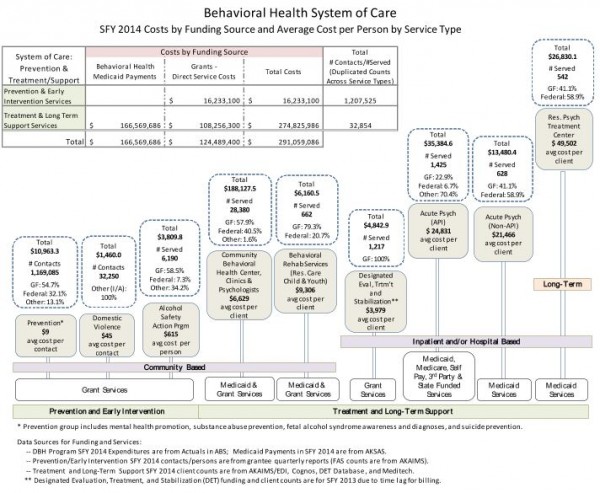
In spite of the alarmingly high rates of substance abuse among teens in Anchorage, many officials say there are reasons for optimism.
All this week, as part of our series “The Blind Spot,” we’ve been exploring holes in the safety net for teens struggling with drugs and alcohol. Now, we look toward solutions.
State officials and non-profit workers told us policy measures are dove-tailing with new evidence that perceptions about drinking are starkly different from realities on the ground.
Under the umbrella of the Department of Health and Human Services, the state is currently trying to shift the paradigm on community health in Alaska, developing new tools to measure what’s working. Diane Casto is the Prevention Manager for the Division of Behavioral Health, and is part of finding new means of assessment, ““Just doing a walk-around, and looking at your community.”
The division’s focus has zoomed out, examining health at the social rather than individual level. “What’s the density of alcohol outlets in your community?” Casto asks, “What are the policies and procedures and practices in your community related to alcohol and drug issues?”
Casto has been doing prevention-related work since 1978, and has seen a wide range of approaches pursued in Alaska. The current trend is away from reactive intervention, and towards prevention.
“The more we work on the front-end, and prevent these issues from becoming catastrophic, the better we will be,” Casto said. A part of the Division’s interest is simple economics: when it comes to substance abuse, preventative measures are significantly less expensive than providing treatment, residential care, and continuing assistance. It is a “reap what you sow” approach.
It costs Casto’s Division about $9 per person to put on a promotional event like a health fair. That is a bargain compared to the $49,502 it costs to provide long-term care to an individual working through acute psychiatric care and recovery. That doesn’t mean every person who stops by a health fair will “just say no” for their whole life. Nor are the expenditures perfect analogues: DBH measures prevention measures as points of contact, where as hospitalization could be days or weeks of intensive management. But on balance, Casto sees prevention as sounder policy.
The Alaska Wellness Coalition has a similar aim. The group is trying to prevent underage drinking by changing community-wide perceptions. The Center for Disease Control’s most recent Youth Risk Behavior Survey says that three-quarters of youth reported not drinking in the past month. The Coalition is using that data to show teens that drinking is actually not the norm.
“What this campaign intends to do is start the conversation,” said campaign coordinator Hope Finkelstein. “Even if people don’t believe that 78%of the kids don’t drink, that’s fine. That is okay, because people will start questioning.”
The Coalition finds youth around the state want to talk about alcohol but haven’t been able to. A similar campaign was launched in Homer a few years ago, when data showed that people there didn’t drink nearly as much as was commonly thought. When the data were released people didn’t believe it. However, it got them talking about it.
There is also an effort to get kids in trouble better. Or, at the very least, to develop an improved system from the Minor Consuming Alcohol charges currently on the books. At the state level, Senate Bill 99 this session attempts to amend Title 4, the state’s alcohol code. The legislation did not advance far, but supporters like Cynthia Franklin, Director of the Alcoholic Beverages Control Board, believe its introduction sets the wheels in motion for meaningful reforms next session.
Professor Marny Rivera at University of Alaska Anchorage’s Justice Center works on the issue, and wants the MCA citation to be replaced with a ticket–like the kinds issued for speeding or parking. Rivera has spent the last few years examining state statutes on alcohol, talking with experts, as well as prosecutors and employees within the Division of Juvenile Justice.
“What we realized is that MCA’s are almost like a gap, or a no-man’s land,” Rivera explained in her office, “DJJ doesn’t deal with these youth until they’ve already come to the attention of the criminal justice system three times.”
Though it may sound counter-intuitive, Rivera wants to help at-risk kids by increasing the number of times they get in trouble, and to ensure the sanctions are meaningful rather than arbitrary.
Police and lawyers know what a long, drawn-out process it can be to see an MCA go through the courts, Rivera said. And they have hearts: they know an MCA makes your name pop up in CourtView, which can jeopardize a young person’s future. Prosecutors across the state regularly decline trying MCA cases, explained the ABC Board’s Franklin, herself a former prosecutor. As a result, kids get slapped on the wrist without an official citation ever being issued. And that is exactly the kind of space where addictive behaviors have room to intensify.
“There’re very few cases where you actually see a habitual status offender or a third time Minor Consuming,” Rivera said. She believes that if underage drinking is a simpler offense it will become easier for officers to write those tickets. And the kids getting ticketed all the time will appear on the justice system’s radar, raising the possibility of early detection and treatment that could have significant impact.
But as the many experts told us, there is no silver bullet. Even if the MCA system is improved, some kids will still end up back where this series started: At the McLaughlin Youth Center.
Ross Blocker stands inside one of the aging treatment cottages on the McLaughlin campus, his fingers interwoven like a nest. Originally from southern Georgia, he’s been in charge of McLaughlin’s Transitional Services Unit for a decade. His goal is making sure kids leave the youth center with the skills they need to survive in the chaotic world.
“You just can’t do all that work then pat ’em on the back, put ’em out the door, and say ‘have a nice day,’” Blocker said. He and his team take the initial treatment plan developed for a new resident at McLaughlin, and draft yet another blue-print to address that kid’s risks and goals. Then, they figure out how to support those elements once the youth has left McLaughlin for the outside.
“Medical needs, mental health, counseling needs, substance abuse needs,” Blocker rattles off, “if they’ve gone through intensive substance abuse here, it just makes sense that they need some kind of support system there.”
Blocker’s treatment unit works with partners in Anchorage like the school district and the Mental Health Trust, and tries to check in on everyone who went through recovery so that they don’t leave 24-hour-a-day structure and enter a total vacuum. They try to give the youth the support they need to keep them out of the statistics.
- The Blind Spot: Spaces Between Statistics
- The Blind Spot: A System of Order Over Chaos
- The Blind Spot: Harm Reduction at the Transit Center
- The Blind Spot: Quitting Meth Alone, Together
Anne Hillman and Zachariah Hughes received Alaska Press Club data journalism fellowships, which helped them produce this story. This coverage is supported by the Recover Alaska Journalism Project fund at the Alaska Community Foundation. Contributors to the fund are Alaska Children’s Trust, Alaska Mental Health Trust Authority, Bristol Bay Native Corporation, John S. And James L. Knight Foundation, Mat-Su Health Foundation, Providence Health & Services Alaska, Rasmuson Foundation and Wells Fargo. More information can be found at www.recoveralaska.org.
Anne Hillman is the healthy communities editor at Alaska Public Media and a host of Hometown, Alaska. Reach her atahillman@alaskapublic.org. Read more about Annehere.
Zachariah Hughes reports on city & state politics, arts & culture, drugs, and military affairs in Anchorage and South Central Alaska.
@ZachHughesAK About Zachariah





